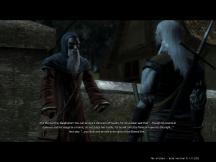Inside The Witcher, Part 1
The story, exploring, dialogue, quests and the interface.
It was mid 2003 that The Witcher was first revealed. An ambitious action/RPG based on the novels by Polish fantasy author Andrzej Sapkowski, the game promises a dark and morally ambiguous gameworld and meaningful choices. After a long development, the release date is finally approaching and CD Projekt Red and Atari have given us unfettered access to a preview copy to experience the gameplay first hand.
And so, armed with our beta code (labeled v0.70 and dated August), we can delve beyond gameplay movies and deep into the game.
Exploring Temeria
Andrzej Sapkowski’s novels and short stories provide a rich background to draw upon and the finer details of the setting and history are complex. Set in the Nordling Realms, The Witcher takes place some time after a bloody war between the empire of Nilfgaard and the elves. A quasi-religious order of monk-knights has arisen from the chaos, seeking to unite the human realms and conquer land from the elves. At a glance, this is a standard fantasy setting but it’s the details that set it apart.
You play the predefined character, Geralt of Rivia – a professional monster hunter and expert swordsman known as a witcher - a small cult who undergo arduous training along with deadly rituals and mutating potions to give them superhuman strength and reflexes – but leaving them not quite human. Their position in society is a reflection of the complex world Sapkowski has shaped – persecuted and feared as mutants but their services are often needed, as they travel the lands slaying monsters for pay. Soon after the game opens, the witchers’ decaying mountain fortress of Kaer Morhen is attacked and the survivors set out in different directions to search for answers.
CD Projekt has instituted two control schemes and each lends a different feel to the game. The first is an isometric-like view with full mouse control and the second is an “over the shoulder” camera that uses WASD keys with mouselook for movement. The over the shoulder view really capitalises on the stunning graphics, which are breathtaking; while it may not have all the bells and whistles of the very latest DX10 titles, the art direction and design is simply superb. There’s clearly a creative vision at work that weaves a compelling, consistent, gritty fantasy world with a medieval Eastern European aesthetic.
When we spoke to CD Projekt back in 2005, they pointed out the use of real world Middle Ages life and architecture for inspiration and this is evident in the actual game. In addition, they’ve made extensive use of schedules and scripts to bring the world to life. Citizens get up in the morning and head to work or their usual haunts, old women sweep the streets, children play hopscotch and soldiers sharpen their blades or practice swordfighting. Inns are busy and noisy with drinking, gambling and boxing matches. Not since the Gothic series have we seen such a realistic, living world steeped in atmosphere. There’s even some sense of context (although it’s hard to tell how far this goes): when it started raining in the city outskirts most of the villagers crowded under cover and I counted a dozen or so different comments such as “horrible weather”, “not rain!” and “quite the storm”. Each of the locations we’ve seen so far has a genuine “lived in” feeling – for instance, a swamp is typically just an excuse for monster hordes but The Witcher adds authenticity with a small, dirty brickmaking community working claypits and loggers taking advantage of the trees.
In the roughly 20 hours we’ve played so far, we’ve seen a mountain fortress, a small village, crypts, sewers, a swamp and the trade quarter of the city of Vizima - the range of environments looks to be diverse. Physically, The Witcher gameworld is divided into some 45 or so locations (see the nearby screenshot of a local map for an example), which each offer a moderately sized chunk to explore. Internal locations – buildings, caves, sewers – all require loading. The loading times can be annoying but hopefully further optimisation before shipping will see improvements – and at least the stylish, painted loading screens are nice. Given the convincing environments you’ll get to explore, it’s sometimes frustrating to be constrained by a low fence or uneven terrain that requires Geralt stick to the path.
Locations are marked with a dot on the local map when you near them and sometimes talking to NPCs or reading books will mark special places in unexplored terrain. The Witcher features a “quest pointer” but, happily, this is entirely optional (more on the interface later). At this stage in the game, we haven’t been able to head off randomly into new areas – locations have opened up as the story unfolds; we’ve been told by CD Projekt in the past that you can generally travel freely, so we assume this must open up further into the game. That said, the early story-based restrictions on travel are at least convincing with a deadly plague enforcing a quarantine in Vizima.
Questing for Choices
So, rather than a completely open “go anywhere” style CRPG, this is more story focused and despite being described as an action/RPG, The Witcher strikes a good balance with dialogue and questing: we’ve probably spent quite a bit more time exploring Vizima and talking to the inhabitants than fighting, though that may change as the game progresses.
The main quest so far has centred on the investigation into the attackers on Kaer Morhen. While there has been a passing mention of an ancient prophecy, the story has been refreshingly rooted in politics and crime, rather than the typical fantasy fare of evil mages and meddlesome gods. Contemporary themes such as racism, prejudice and terrorism are clearly reflected in the story and quests as the trail illuminates elves and dwarves fighting against xenophobia with guerrilla warfare and petty local crime underpinning a drug-running operation.
The side-quests range from large multi-phase story-related affairs to simple “kill” or “gather” contracts (such as “Alchemist will pay 200 orens for five drowner brains”), which can be found on town noticeboards. These optional commissions are basic fare but they at least make sense (Geralt is a monster-hunter for hire) and The Witcher adds a simple twist – you’ll first need to find or buy books that explain the collection of each alchemical ingredient before you can harvest them.
One of the key features promoted by CD Project is meaningful choices that impact the gameworld, as well as the intriguing idea that the consequences may not become evident until several hours of play later – you’ve probably seen some of the videos or read previews from E3 with examples. The idea is that we can’t always foresee the outcome of our actions in real life – and saving and reloading to try different paths in a game undermines the basic concept of living with meaningful choices. For The Witcher, this means that while a dialogue choice or action has some sort of immediate outcome (whether you kill an NPC or not, for example), this changes the gameworld in some way that has consequences well down the track. The big question is: how important are these choices? It’s hard to discuss this without major spoilers and without finishing the game a number of times. What we can say is that we’ve seen a number of choices in quests and at least two of the “major” branches, which lead to flashback cutscenes when the repercussions are revealed.
These choices take a number of forms. In the outskirts of Vizima, a conflict born out of prejudice and hatred leads to a climactic confrontation, with Geralt caught between the two parties. The decision to support one or the other is morally ambiguous (depending on the player’s perspective, the “guilty” party isn’t straight forward), and the choice changes how the player enters the city. Later, what seems a chance minor encounter turns out to be a useful ally, depending on your earlier approach. Conversely, players who take the other option will never know about the help they could have received and will need to find another route.
Other examples include siding with or against a local crime boss, using bribes or gifts to grease the way forward and the well-known E3 example of whether or not to turn over a cache of weapons to a group of insurgents. In our game, we opted to protect the goods, which resulted in a battle. What we didn’t know was that the trader who owned the weapons had been illegally dealing with the terrorist group and became nervous that the battle would draw questions from the authorities. Opting to be proactive, he turned in the insurgents…which meant one of the contacts we needed information from later on was imprisoned.
The consequences range from changes in the story, to pursuing a different line of quests to finding an alternative solution to simply paying a bribe. Of course, with this design philosophy it’s entirely possible that the choice to do a particular quest (or turn it down, for that matter) may have unknowingly shunted our current game down a different but yet to be revealed track. All that said, it’s important not to paint The Witcher as some sort of medieval action Fallout. This is an innovative – even brave – design choice but not every quest supports multiple solutions and each choice we’ve seen is binary. We understand there are some 12 or so major decision points throughout the game and with six chapters and two story episodes in each chapter, it looks to us like there is probably one major plot branch in each story sub-arc, as well as a solid sprinkling of other quests with choices or different approaches.
Translating
Eastern European developments don’t have a great history of stability and good localisations but we’re happy to report this is looking good. The translation is solid and the voiceacting ranges from adequate to excellent – generally a cut above average. Occasionally some awkward phrasing creeps in and some of the dialogue feedback is abrupt but, on the whole, Atari seems to have done a good job.
Tracking all this is an effective interface with one of the most comprehensive journals we’ve seen. Additional text is added to the log every time a quest moves forward, so you can easily see read back through the history and long quests are broken up into “phases”. New entries and additions are highlighted in yellow and there are plenty of filtering options, such as displaying main or side quests only or the entries from a particular chapter. The journal also contains similar entries for characters, places, monsters, ingredients and more, forming a detailed resource. The presentation is a little flashy and could be dialled back but otherwise, it’s a well thought out system. Add the annotated map and optional quest-pointer and The Witcher is easy to navigate while letting players choose their own approach.
Part Two of our hands-on look will be up in the next couple of days, where we’ll look at character development, combat, alchemy, minigames and more!

Information about
The WitcherDeveloper: CD Projekt RED
SP/MP: Single-player
Setting: Fantasy
Genre: RPG
Combat: Pausable Real-time
Play-time: Over 60 hours
Voice-acting: Full
Regions & platforms
World
· Homepage
· Platform: PC
· Released: 2007-10-26
· Publisher: Atari
More information







